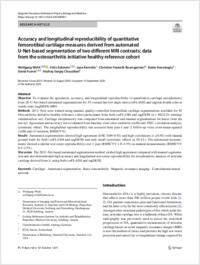Accuracy and longitudinal reproducibility of quantitative femorotibial cartilage measures derived from automated U-Net-based segmentation of two different MRI contrasts: data from the osteoarthritis initiative healthy reference cohort.
- Wirth W Department of Imaging and Functional Musculoskeletal Research, Institute of Anatomy and Cell Biology, Paracelsus Medical University Salzburg and Nuremberg, Strubergasse 21, 5020, Salzburg, Austria. wolfgang.wirth@pmu.ac.at.
- Eckstein F Department of Imaging and Functional Musculoskeletal Research, Institute of Anatomy and Cell Biology, Paracelsus Medical University Salzburg and Nuremberg, Strubergasse 21, 5020, Salzburg, Austria.
- Kemnitz J Department of Imaging and Functional Musculoskeletal Research, Institute of Anatomy and Cell Biology, Paracelsus Medical University Salzburg and Nuremberg, Strubergasse 21, 5020, Salzburg, Austria.
- Baumgartner CF ETH, Zurich, Switzerland.
- Konukoglu E ETH, Zurich, Switzerland.
- Fuerst D Department of Imaging and Functional Musculoskeletal Research, Institute of Anatomy and Cell Biology, Paracelsus Medical University Salzburg and Nuremberg, Strubergasse 21, 5020, Salzburg, Austria.
- Chaudhari AS Department of Radiology, Stanford University, Stanford, CA, USA.
- 2020-10-07
Published in:
- Magma (New York, N.Y.). - 2020
Automated segmentation
Cartilage
Convolutional neural network
Knee osteoarthritis
Magnetic resonance imaging
English
OBJECTIVE
To evaluate the agreement, accuracy, and longitudinal reproducibility of quantitative cartilage morphometry from 2D U-Net-based automated segmentations for 3T coronal fast low angle shot (corFLASH) and sagittal double echo at steady-state (sagDESS) MRI.
METHODS
2D U-Nets were trained using manual, quality-controlled femorotibial cartilage segmentations available for 92 Osteoarthritis Initiative healthy reference cohort participants from both corFLASH and sagDESS (n = 50/21/21 training/validation/test-set). Cartilage morphometry was computed from automated and manual segmentations for knees from the test-set. Agreement and accuracy were evaluated from baseline visits (dice similarity coefficient: DSC, correlation analysis, systematic offset). The longitudinal reproducibility was assessed from year-1 and -2 follow-up visits (root-mean-squared coefficient of variation, RMSCV%).
RESULTS
Automated segmentations showed high agreement (DSC 0.89-0.92) and high correlations (r ≥ 0.92) with manual ground truth for both corFLASH and sagDESS and only small systematic offsets (≤ 10.1%). The automated measurements showed a similar test-retest reproducibility over 1 year (RMSCV% 1.0-4.5%) as manual measurements (RMSCV% 0.5-2.5%).
DISCUSSION
The 2D U-Net-based automated segmentation method yielded high agreement compared with manual segmentation and also demonstrated high accuracy and longitudinal test-retest reproducibility for morphometric analysis of articular cartilage derived from it, using both corFLASH and sagDESS.
To evaluate the agreement, accuracy, and longitudinal reproducibility of quantitative cartilage morphometry from 2D U-Net-based automated segmentations for 3T coronal fast low angle shot (corFLASH) and sagittal double echo at steady-state (sagDESS) MRI.
METHODS
2D U-Nets were trained using manual, quality-controlled femorotibial cartilage segmentations available for 92 Osteoarthritis Initiative healthy reference cohort participants from both corFLASH and sagDESS (n = 50/21/21 training/validation/test-set). Cartilage morphometry was computed from automated and manual segmentations for knees from the test-set. Agreement and accuracy were evaluated from baseline visits (dice similarity coefficient: DSC, correlation analysis, systematic offset). The longitudinal reproducibility was assessed from year-1 and -2 follow-up visits (root-mean-squared coefficient of variation, RMSCV%).
RESULTS
Automated segmentations showed high agreement (DSC 0.89-0.92) and high correlations (r ≥ 0.92) with manual ground truth for both corFLASH and sagDESS and only small systematic offsets (≤ 10.1%). The automated measurements showed a similar test-retest reproducibility over 1 year (RMSCV% 1.0-4.5%) as manual measurements (RMSCV% 0.5-2.5%).
DISCUSSION
The 2D U-Net-based automated segmentation method yielded high agreement compared with manual segmentation and also demonstrated high accuracy and longitudinal test-retest reproducibility for morphometric analysis of articular cartilage derived from it, using both corFLASH and sagDESS.
- Language
-
- English
- Open access status
- hybrid
- Identifiers
-
- DOI 10.1007/s10334-020-00889-7
- PMID 33025284
- Persistent URL
- https://folia.unifr.ch/global/documents/263677
Statistics
Document views: 18
File downloads:
- fulltext.pdf: 0
